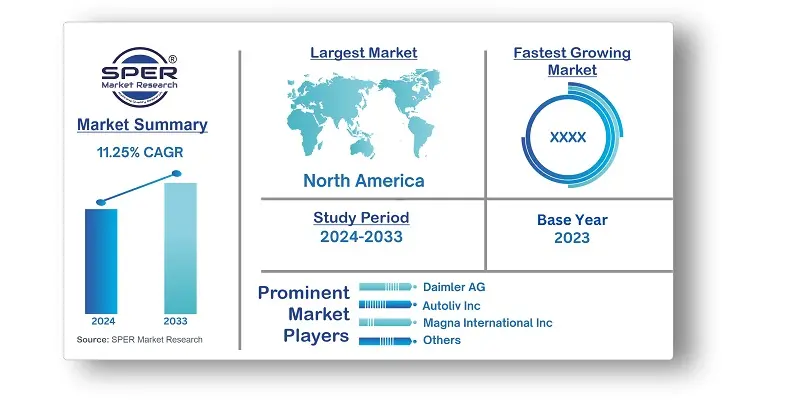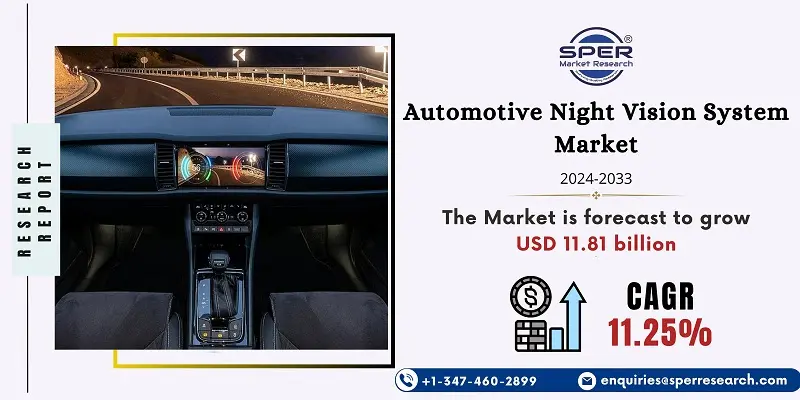
Automotive Night Vision System Market Growth, Size, Trends, Share, Revenue and Future Outlook
Automotive Night Vision System Market Size - By Technology Type, By Display Type, By Vehicle Type, By Component Type- Regional Outlook, Competitive Strategies and Segment Forecast to 2033
| Published: Apr-2024 | Report ID: AMIN24118 | Pages: 1 - 236 | Formats*: |
| Category : Automotive & Transportation | |||
- Opel declared in January 2022 that the darkness Vision technology, which turns darkness into day and improves everyone's safety on the road at twilight and in the dark, would be available on its new SUV, the Grandland. The Opel Vizor's infrared camera and the adaptable IntelliLux LED Pixel Light are hidden behind it. With 168 LED elements—84 for each headlamp—the lighting technology offers a smooth beam adaption based on the driving conditions and environment.
- In September 2021, Hanwha Systems Co., Ltd. (Hanwha Systems) stated that the business and Truwin Co., Ltd. (Truwin) had agreed to form a joint venture to develop and manufacture infrared sensors and other vehicle sensors by the end of 2021. The new joint venture will manufacture infrared sensors for autonomous vehicles' night vision systems.
- The thermal imaging and night vision technology company FLIR is being acquired by Teledyne Technologies for USD 8 billion, the company stated in January 2021.
 Market Opportunities and Challenges
Market Opportunities and Challenges
| Report Metric | Details |
| Market size available for years | 2020-2033 |
| Base year considered | 2023 |
| Forecast period | 2024-2033 |
| Segments covered | By Technology Type, By Display Type, By Vehicle Type, By Component Type |
| Regions covered | North America, Asia-Pacific, Latin America, Middle East & Africa and Europe |
| Companies Covered | Robert Bosch GmbH, DENSO Corporation, Audi AG, Daimler AG, Autoliv Inc, Visteon Corporation, Magna International Inc, L3 Technologies Inc, Raytheon Company, Aisin Seiki Co Ltd, Delphi Automotive PLC, Valeo SA, Hella KGaA Hueck & Co, FLIR Systems Inc. |
- Consulting and Research Firm
- Venture capitalists
- Third-party knowledge providers
- Government Authorities
- Value-Added Resellers (VARs)
| By Technology Type: |
|
| By Display Type: |
|
| By Vehicle Type: |
|
| By Component Type: |
|
- Global Remote Automotive Night Vision System Market Size (FY’2024-FY’2033)
- Overview of Global Automotive Night Vision System Market
- Segmentation of Global Automotive Night Vision System Market By Technology Type (Far Infrared, Near Infrared)
- Segmentation of Global Automotive Night Vision System Market By Display Type (Navigation System, Instrument Cluster, HUD)
- Segmentation of Global Automotive Night Vision System Market By Vehicle Type (Commercial Vehicle, Passenger Cars)
- Segmentation of Global Automotive Night Vision System Market By Component Type (Night Vision Camera, Controlling Unit, Display Unit, Sensor, Others)
- Statistical Snap of Global Automotive Night Vision System Market
- Expansion Analysis of Global Automotive Night Vision System Market
- Problems and Obstacles in Global Automotive Night Vision System Market
- Competitive Landscape in the Global Automotive Night Vision System Market
- Impact of COVID-19 and Demonetization on Global Automotive Night Vision System Market
- Details on Current Investment in Global Automotive Night Vision System Market
- Competitive Analysis of Global Automotive Night Vision System Market
- Prominent Players in the Global Automotive Night Vision System Market
- SWOT Analysis of Global Automotive Night Vision System Market
- Global Automotive Night Vision System Market Future Outlook and Projections (FY’2024-FY’2033)
- Recommendations from Analyst
1.1. Scope of the report1.2. Market segment analysis
2.1. Research data source2.1.1. Secondary Data2.1.2. Primary Data2.1.3. SPER’s internal database2.1.4. Premium insight from KOL’s2.2. Market size estimation2.2.1. Top-down and Bottom-up approach2.3. Data triangulation
4.1. Driver, Restraint, Opportunity and Challenges analysis4.1.1. Drivers4.1.2. Restraints4.1.3. Opportunities4.1.4. Challenges4.2. COVID-19 Impacts of the Global Automotive Night Vision System Market.
5.1. SWOT Analysis5.1.1. Strengths5.1.2. Weaknesses5.1.3. Opportunities5.1.4. Threats5.2. PESTEL Analysis5.2.1. Political Landscape5.2.2. Economic Landscape5.2.3. Social Landscape5.2.4. Technological Landscape5.2.5. Environmental Landscape5.2.6. Legal Landscape5.3. PORTER’s Five Forces5.3.1. Bargaining power of suppliers5.3.2. Bargaining power of buyers5.3.3. Threat of Substitute5.3.4. Threat of new entrant5.3.5. Competitive rivalry5.4. Heat Map Analysis
6.1. Global Automotive Night Vision System Market Manufacturing Base Distribution, Sales Area, Product Type6.2. Mergers & Acquisitions, Partnerships, Product Launch, and Collaboration in Global Automotive Night Vision System Market
7.1. Global Automotive Night Vision System Market Size, Share and Forecast, By Technology Type, 2020-20267.2. Global Automotive Night Vision System Market Size, Share and Forecast, By Technology Type, 2027-20337.3. Far Infrared (FIR)7.4. Near Infrared (NIR)
8.1. Global Automotive Night Vision System Market Size, Share and Forecast, By Display Type, 2020-20268.2. Global Automotive Night Vision System Market Size, Share and Forecast, By Display Type, 2027-20338.3. Navigation System8.4. Instrument Cluster8.5. HUD
9.1. Global Automotive Night Vision System Market Size, Share and Forecast, By Vehicle Type, 2020-20269.2. Global Automotive Night Vision System Market Size, Share and Forecast, By Vehicle Type, 2027-20339.3. Commercial Vehicle9.4. Passenger Cars
10.1. Global Automotive Night Vision System Market Size, Share and Forecast, By Component Type, 2020-202610.2. Global Automotive Night Vision System Market Size, Share and Forecast, By Component Type, 2027-203310.3. Night Vision Camera10.4. Controlling Unit10.5. Display Unit10.6. Sensor10.7. Others
11.1. Global Automotive Night Vision System Market Size and Market Share
12.1. Global Automotive Night Vision System Market Size and Market Share By Region (2020-2026)12.2. Global Automotive Night Vision System Market Size and Market Share By Region (2027-2033)12.3. Asia-Pacific12.3.1. Australia12.3.2. China12.3.3. India12.3.4. Japan12.3.5. South Korea12.3.6. Rest of Asia-Pacific12.4. Europe12.4.1. France12.4.2. Germany12.4.3. Italy12.4.4. Spain12.4.5. United Kingdom12.4.6. Rest of Europe12.5. Middle East and Africa12.5.1. Kingdom of Saudi Arabia12.5.2. United Arab Emirates12.5.3. Qatar12.5.4. South Africa12.5.5. Egypt12.5.6. Morocco12.5.7. Nigeria12.5.8. Rest of Middle-East and Africa12.6. North America12.6.1. Canada12.6.2. Mexico12.6.3. United States12.7. Latin America12.7.1. Argentina12.7.2. Brazil12.7.3. Rest of Latin America
13.1. Robert Bosch GmbH13.1.1. Company details13.1.2. Financial outlook13.1.3. Product summary13.1.4. Recent developments13.2. DENSO Corporation13.2.1. Company details13.2.2. Financial outlook13.2.3. Product summary13.2.4. Recent developments13.3. Audi AG13.3.1. Company details13.3.2. Financial outlook13.3.3. Product summary13.3.4. Recent developments13.4. Daimler AG13.4.1. Company details13.4.2. Financial outlook13.4.3. Product summary13.4.4. Recent developments13.5. Autoliv Inc.13.5.1. Company details13.5.2. Financial outlook13.5.3. Product summary13.5.4. Recent developments13.6. Visteon Corporation13.6.1. Company details13.6.2. Financial outlook13.6.3. Product summary13.6.4. Recent developments13.7. Magna International Inc.13.7.1. Company details13.7.2. Financial outlook13.7.3. Product summary13.7.4. Recent developments13.8. L3 Technologies Inc.13.8.1. Company details13.8.2. Financial outlook13.8.3. Product summary13.8.4. Recent developments13.9. Raytheon Company13.9.1. Company details13.9.2. Financial outlook13.9.3. Product summary13.9.4. Recent developments13.10. Aisin Seiki Co Ltd13.10.1. Company details13.10.2. Financial outlook13.10.3. Product summary13.10.4. Recent developments13.11. Delphi Automotive PLC13.11.1. Company details13.11.2. Financial outlook13.11.3. Product summary13.11.4. Recent developments13.12. Valeo SA13.12.1. Company details13.12.2. Financial outlook13.12.3. Product summary13.12.4. Recent developments13.13. Hella KGaA Hueck & Co.13.13.1. Company details13.13.2. Financial outlook13.13.3. Product summary13.13.4. Recent developments13.14. FLIR Systems Inc.13.14.1. Company details13.14.2. Financial outlook13.14.3. Product summary13.14.4. Recent developments13.15. Others
SPER Market Research’s methodology uses great emphasis on primary research to ensure that the market intelligence insights are up to date, reliable and accurate. Primary interviews are done with players involved in each phase of a supply chain to analyze the market forecasting. The secondary research method is used to help you fully understand how the future markets and the spending patterns look likes.
The report is based on in-depth qualitative and quantitative analysis of the Product Market. The quantitative analysis involves the application of various projection and sampling techniques. The qualitative analysis involves primary interviews, surveys, and vendor briefings. The data gathered as a result of these processes are validated through experts opinion. Our research methodology entails an ideal mixture of primary and secondary initiatives.



Frequently Asked Questions About This Report
PLACE AN ORDER
Year End Discount
Sample Report
Pre-Purchase Inquiry
NEED CUSTOMIZATION?
Request CustomizationCALL OR EMAIL US
100% Secure Payment






Related Reports
Our Global Clients
Our data-driven insights have influenced the strategy of 200+ reputed companies across the globe.






















